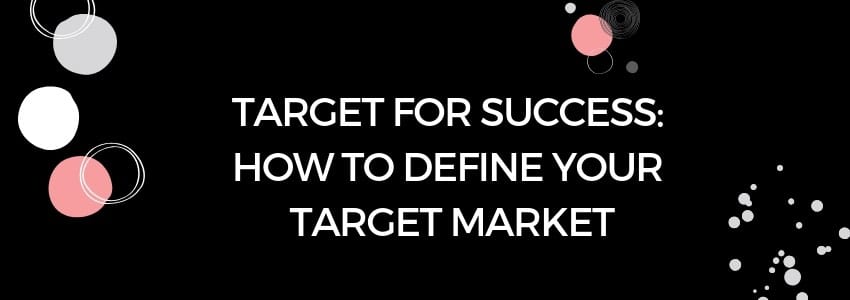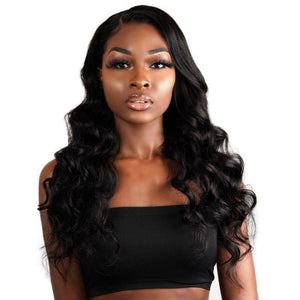Target for Your Business
Congratulations! You’ve made the first step. You decided weeks ago or months ago that you were going to break into
the hair industry by becoming a hair extension retailer. Maybe you are an avid weave wearer who knows the difference between 7A, 8A, & 9A bundles and you decided to sell what you love to help enhance the beauty of other women around the world. Or maybe you’ve never worn an installation in your life, but you know that the hair industry is worth billions of dollars and you are ready for your slice of the pie. Unfortunately, both scenarios are irrelevant when it comes to
selling hair extensions and planning your business. Don’t get me wrong; your "Why?" is always important! Your "Why?" is what will keep you pushing when orders don’t start rolling in right away, or the influencer you hired is late on their review. However, to get started making money through your
hair extension business you need to know who you are selling to and you need to know them very well. These people, this audience is your target market. Your target market will be on the receiving end of your marketing plan. You will invest time and money trying to reach them so you should at least know who they are before you start.
B2C vs. B2B
When first deciding who you are going to cater your hair extensions you should know that you have options. Most companies choose early on that they will sell directly to a consumer that is their end user. They will buy at the wholesale price and then engaged in a few
marketing tactics like posting a few pictures on Instagram, get a Youtuber to review the hair, throw an affiliate link in the mix, and begin to collect orders slowly but surely. B2C is a Business to Consumer method. This route is traditional, and a lot of small businesses use this business model to sell their products. The B2B or Business to Business model is in direct contrast to the B2C model because it involves one company selling directly to another business which is typically not the end user. The standard chain includes wholesalers selling to retailers or manufacturers. The day to day consumer is not a participant in this transaction. If you are looking to become a
hair vendor to hair retailers or salons, you will consider the B2B route. In some cases, you may want to consider targeting both consumers and other businesses to
diversify your target market. However, it is important to remember that you cannot be all things to all people and this is especially true in the realm of business. The more you can narrow in on who your customer is, the better you will be able to serve them, and this service will ensure that they keep coming back. Keep reading for the steps on how to define your niche below:
1. Take a look at Your Competition
The hair industry is suffering from saturation with the abundance of beauty supply stores, internet hair companies, and quick weave shops. There is no shortage of competitors in this business. Take advantage of that resource and
research your competitors. Who is the company catering to with these ads? Are they only using celebrity endorsements? Does this mean that their prices are unrealistic to the everyday consumer? A question like that makes you dig deeper and ask, who is this company trying to sell to, and does the marketing do that efficiently? If no, does that mean that you can use micro-influencers to sell your hair and capitalize on an affordability aspect? Take heed to all of the answers to the above questions. You can look at all this information and choose to target someone entirely different for them or better execute their strategy. This information can add to your list in step one and aid in your customer discovery process.
2. Analyze Your Product and Conduct Market Research
Decide on what type of hair you are going to sell and what are the benefits associated with this hair. If you are using Private Label Extensions hair, you may choose to sell only the
Brazilian hair that they offer. You can then break down your hair extension assortment by curl patterns and create a small list for each item in your line. For Example:
Brazilian Straight 8A hair
- Manageable
- Colors well
- Can be curled with heat tools
- Has a life of over 1.5 years
Brazilian Afro Kinky
- Matches natural textures
- Can be made into clip-ins
- Colors well
- Can be straightened or blow dried
These are just a few benefits, but once you have these listed out make a separate list of people who need these benefits. A B2C example may be, a twenty-something naturalista who lacks the versatility of
Brazilian Afro Kinky clip ins because she is always on the go but does not like to apply much heat to her hair. Knowing how your product will fit into your target market’s lifestyle will help you reach them where they are. The same applies to the B2B customer you may want to service, pitch your natural hair extensions to a salon that specializes in curls because that is a market that is underserved. You can justify their needs when you compare the current offering of natural hair extensions to the vast options of straight hair extensions available. Please note that these examples are general, but you now have a base to start your analysis!
3. Make a List
Test question: Who do you want to buy your hair? If your answer is everyone,
wrong. Or, if your answer is African American Women that is better but still wrong. If your answer is African American women between the ages of 25-35 who make over $45,000 a year and spend their residual income on hair and beauty products, you may be on to something. Write down your customer and list out particular details. Who is she? What kind of money does she make? What are her spending habits? Where does she get her information? All of these questions are going to help you reach her. You need to write the answers down so that you can always go back to her if you notice your branding or marketing is getting off track or not penetrating the market you are interested in reaching. It is imperative to note that just because you are catering to this customer does not mean that you are limiting yourself. Remember, your marketing dollars will funnel into campaigns reaching these people, and your sales will reflect the person you are describing in this step. Be sure to use the information gathered in the last two steps to help create this list! Here is a more precise list of the information you need to build your list.
Be sure you can provide these characteristics to your ideal customers:
- Age
- Location
- Gender
- Income level
- Education level
- Marital or family status
- Occupation
- Ethnic background
It is also important to look at the Psychographics of your customer.
These are their more personal characteristics:
- Personality
- Attitudes
- Values
- Interests/hobbies
- Lifestyles
- Behavior
Additionally, It is good to know the psychographics of your customer because that can help you to understand your their frame of mind and enable you to reach them directly with your sales and marketing channels.
4. Test
Give your target market an opportunity to buy from you. A test does not mean a company launch; it means a soft opening or an exclusive offering. You can also do a market test by giving out free samples to a few people. It's great to see if your target market will be responsive to your product and or branding choices. The test will give you time to pivot your product line or fine tune your audience if they do not respond to the lengths, textures, or marketing campaign you have put in place. For example, if you are going to offer Brazilian hair extensions, you could purchase what you think would be your top 3 to 5 different textures. Select them after doing a product analysis of the PLE hair assortment. Make sure you purchase enough for 5 to 10 people. With the industry standard for a full head weave being 15 to 30 bundles, you can buy anywhere between that amount bracket. Then launch your marketing campaign to a controlled number of people or salons within your target market. Look to see what textures go first in a set amount of time, and that will not only be your winning product assortment, but you can also study what you did or communicated to your customer base through those winners. You can then fine-tune your customer and execute a launch that will hit your target.
Target To Success
A
target market is a group of people with similar needs and wants who can potentially become your customer. It is vital that you know who these people or businesses are so that you can accurately target them with the correct marketing tools and bring them to your product. You do that by competitive shopping, conducting market research and make a wish list of who you want your customers to be. How have you gone about finding your target market? Leave tips in the comments below.



5 comments
Who ismy target customer and how will i find them?
I want to start a hair extension business
How do I know my target audience because there are so many wigs
Hey I just wanted to ask am a bit confused I handmake luxurious hair bonnets . Who are my target audience am confused
This is an interesting article
I need help to start my own hair products business